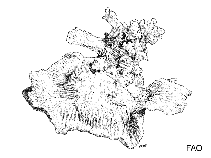Caulastraea furcata Dana, 1846
Torch coral
Upload your photos
Google image | No image available for this species;
drawing shows typical species in Merulinidae.
Google image | No image available for this species;
drawing shows typical species in Merulinidae.
Classification / Names Common names | Synonyms | CoL | ITIS | WoRMS
Anthozoa | Scleractinia | Merulinidae
Environment: milieu / climate zone / depth range / distribution range Ecology
Reef-associated; depth range 0 - 40 m (Ref. 848). Tropical; 30°N - 27°S, 39°E - 172°W (Ref. 848)
Distribution Countries | FAO areas | Ecosystems | Occurrences | Introductions
Indo-Pacific: From Somalia and Madagascar, east to the Samoas, north to Ryukyu, south to New Caledonia.
Length at first maturity / Size / Weight / Age
Maturity: Lm ? range ? - ? cm
Short description Morphology
Formation: phaceloid. Corallites: irregular, crowded if in restricted space; less than 19 mm across. Septa: exsert, irregular, varying thickness. Polyps: fleshy; thick septa give prominent radiating stripes to the upper corallite surface. Color: brown or green with green oral discs (Ref. 848).
Occurs in protected reef slopes with partly sandy substrate (Ref. 848). Also in lagoons (Ref. 98471). No bleaching observed in Palau (Ref. 66144).
Life cycle and mating behavior Maturity | Reproduction | Spawning | Eggs | Fecundity | Larvae
Hermaphroditic (Ref. 113712). Mature gametes are shed into the coelenteron and spawned through the mouth. Life cycle: The zygote develops into a planktonic planula larva. Metamorphosis begins with early morphogenesis of tentacles, septa and pharynx before larval settlement on the aboral end (Ref. 833).
Main reference
References | Coordinator | Collaborators
Nemenzo, F. Sr. 1986. (Ref. 910)
IUCN Red List Status (Ref. 130435)
Least Concern (LC) ; Date assessed: 01 January 2008
CITES status (Ref. 108899)
Appendix II: International trade monitored
CMS (Ref. 116361)
Not Evaluated
Threat to humans
Human uses
| FishSource |
Tools
More information
Internet sources
BHL | BOLD Systems | CISTI | DiscoverLife | FAO(Publication : search) | Fishipedia | GenBank (genome, nucleotide) | GloBI | Gomexsi | Google Books | Google Scholar | Google | PubMed | Hexacorallians of the World | Tree of Life | Wikipedia (Go, Search) | Zoological Record
Estimates based on models
Preferred temperature
(Ref. 115969): 25 - 29, mean 28 (based on 804 cells).
Price category
(Ref. 80766):
Unknown.



